The Climate In The Jurassic Era
The Jurassic period, which occurred 208 to 146 million years ago, marks the middle of the Mesozoic era, known as the age of dinosaurs. Pangaea, the giant land mass, began to break up and sea levels rose. Evidence indicates that temperatures on Earth were more equable in the Jurassic period than they are today. Temperate zones likely experienced a climate that was more like present-day subtropical and tropical climates. The absence of ice caps in the polar regions suggests that the climate in that area was temperate.
TL;DR (Too Long; Didn't Read)
The climate of the Jurassic period was warmer than many modern-day climates. Modern temperate biomes experienced a tropical climate, and polar regions had a temperate climate.
Flora and Fauna of the Jurassic
Flora and Fauna of the Jurassic
Reptiles flourished on land as well as in the sea. The number and diversity of dinosaur species exploded during this period. The first birds evolved in the Jurassic period, and marine life became more varied and prolific. This was also the age of cycads: seed-bearing plants that resemble palms but do not produce fruit. Ferns and conifers were prolific during this period, but flowering plants that bear fruit were not present in the Jurassic period.
Geological Markers
Geological Markers
From a geologic perspective, a large amount of climatic evidence for the Jurassic period comes from evaporites. Evaporites are mineral deposits, such as gypsum and halites, that are left behind after a body of water evaporates. Deposits of mineral salts indicate deserts that were once covered by lakes or seas. These regions would likely have had a dry climate. Coals also offer insight into prehistoric climates. The presence of coals indicates a humid climate where land was covered by swamps or other wetlands. The location of bands of halite and coal deposits suggests that the climate close to the equator was arid and higher latitudes had a wetter climate. The lack of glaciation during the Jurassic period also indicates that Earth's average temperature was warmer than present day temperatures.
Plants in the Polar Regions
Plants in the Polar Regions
Fossil evidence of ferns and cone-producing plants at the poles suggests that the climate in these regions was much warmer during the Jurassic period than in present day. The wide distribution of certain species of prehistoric ferns across many degrees of latitude supports claims that there was not as great a disparity of temperature between the equator and the polar regions as there is today. The diversity of ferns, palms, and needle-bearing trees in the Jurassic period shows that the climate must have been warm and humid.
Faunal Evidence
Faunal Evidence
The theory that worldwide temperatures did not fluctuate greatly is also supported by the fossil evidence of Jurassic fauna and the distribution of species across vast regions of the globe. Paleontologists often use the physiology of modern-day reptiles as a basis for hypothesizing about the physiology of dinosaurs and other reptiles of the Jurassic period. Because modern reptiles are ectotherms and cannot maintain their body heat, they are restricted to living in climates that provide adequate heat for them to maintain their metabolism. Scientists assume that Jurassic reptiles had similar climatic requirements and postulate that temperatures were warm enough to sustain reptilian life in the regions where these fossils are found.
References
Cite This Article
MLA
Mentzer, A.P.. "The Climate In The Jurassic Era" sciencing.com, https://www.sciencing.com/climate-jurassic-era-4932/. 23 April 2018.
APA
Mentzer, A.P.. (2018, April 23). The Climate In The Jurassic Era. sciencing.com. Retrieved from https://www.sciencing.com/climate-jurassic-era-4932/
Chicago
Mentzer, A.P.. The Climate In The Jurassic Era last modified March 24, 2022. https://www.sciencing.com/climate-jurassic-era-4932/
